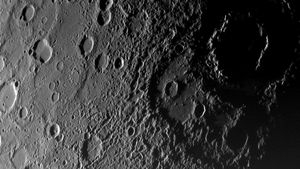
All of the planets in our Solar System have had a lot of craters. This was especially true in the past when there were many more asteroids traveling in our solar system than there are today. On planets like Venus, Earth, and Mars, we do not see as many craters because most of them have been eroded away by wind, rain, volcanic activity, and other forces. On the giant gas planets, Jupiter, Saturn, Uranus, and Neptune, we do not see any craters because there is no visible solid surface for the meteors to hit. On Mercury, where there is no atmosphere, there is no weather to erode away the craters, so most of the craters are still visible.
Craters are the most widespread landforms in the solar system. Craters are found on all of the terrestrial planets—Mercury, Venus, Earth and Mars. The surfaces of asteroids and the rocky, ice covered moons of the outer gas planets are cratered as well. The craters left by impacting objects can reveal information about the age of a planet’s surface and the nature and composition of the planet’s surface at the time the crater was formed.
Impact craters dominate the surfaces of Mercury and the Earth’s Moon. Both bodies lack liquid water on their surfaces that would erode impact craters over time. They also lack an atmosphere which, on planets like the Earth and Venus, could disintegrate meteoroids before they impact the surface. However, old craters can be eroded by new impact events. Mercury and the Moon have very old surfaces. One of the youngest large craters on the Moon is Tycho, which was formed about 109 million years ago.
Picture Credit : Google




